If you see a local ash tree quaking like an aspen, it's probably just heard the news from the Missouri Department of Conservation.
The MDC reported Thursday that emerald ash borers have reached Callaway County. New detections have also been confirmed in Adair, Cape Girardeau, Cole, Greene, Jefferson, Lewis, Lincoln, Pike, Polk and Warren counties.
Since EAB was first detected in Missouri in July 2008, the exotic, tree-killing pest has spread to a total of 53 Missouri counties and the City of St. Louis.
EAB is a small, metallic green beetle native to Asia that only attacks ash trees, the MDC explained. The adult beetle does very little damage. In its larval stage, however, EAB bores into the vascular layer of ash trees, creating distinct S-shaped trenches that slowly cut off the trees' flow of water and nutrients, eventually causing the trees to die. Unfortunately, EAB kills more than 99 percent of the ash trees it attacks within three to four years of infestation.
MDC Forest Entomologist Robbie Doerhoff urges people who own ash trees in areas where EAB has been found to make a plan now to either treat or remove those trees. The presence of emerald ash borers in a county doesn't have to be a death sentence for every ash tree - but the trees must be proactively protected.
"If you have a healthy, high-value ash tree in your yard, it can be treated with insecticides that will protect it from EAB. However, these treatments must be applied every year or two to guarantee protection," Doerhoff said. "For some ash trees, especially those that have already lost more than 50 percent of their leaves and branches, the best option is removal, followed by replanting with a different species, such as an oak native to Missouri."
Insecticide treatments sold in hardware stores are only useful on trees smaller than 20 inches in diameter. Larger trees will have to be treated by professionals, Doerhoff said.
Doerhoff suggested using a reputable company and getting a couple of bids. Some neighborhoods receive discounts if several people have ash trees treated by the same company.
"If you decide to treat your ash tree, make sure you use a pesticide labeled to kill EAB and that you apply it at the right time of year," Doerhoff said. "Chemical treatments are most effective in early spring when a tree's vascular system is better able to take up the insecticide. In late summer, and especially during drought conditions like we're currently experiencing across most of Missouri, treatments may not work properly."
Ash trees that are removed should be disposed of locally to prevent the accidental spread of EAB to new locations. EAB can emerge from ash firewood and logs for up to two years after harvest, so don't give EAB a free ride to your favorite camping locations. Buy firewood near where you plan to burn it.
For more information on protecting your ash tree from EAB, download the Emerald Ash Borer Management Guide for Missouri Homeowners at short.mdc.mo.gov/ZSq.

